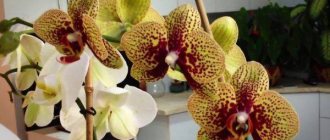Mirabilis flower is a plant from the Nyctaginaceae family, which includes more than fifty species. In the wild, it is found in various climatic zones - from the tropics to the temperate zone.
Author of the article
Anna Dmitrieva
Gardener with 15 years of experience.
It is most widespread on the American continent; there is one species native to South Asia. The name is Latin, in Russian it sounds like “amazing”. The place of origin of the most commonly found variety of jalapa is Mexico.
Origin of Mirabilis
Bright tropical flowers with an unusual name are herbaceous plants. The Niktaginov family includes more than five dozen species.
Southern Guest Flower
Unfortunately, only one variety of night-blooming bushes has taken root in Russia. They call it Jalapa, but due to the lack of related species, the flower received the name of the entire family. The variegated flowers growing in the Russian Federation are simply called mirabilis.
And even on Russian soil, mirabilis has chosen a certain climate. He liked the warm southern latitudes. Since its homeland is South America, and the species itself is perennial, the bushes need moderate winters, which they found in the Russian outback.
Interesting! Mirabilis is often called the Night Beauty. It's all about the time of its flowering. The plant keeps the bud closed all day, and only in the evening the flower blooms.
Flowering lasts throughout the dark part of the day, and the next morning the bud fades.
Lush color
While one flower fades, the plant immediately produces new buds. The flowering season lasts until the first frost. Mirabilis often decides to bloom a flower in cloudy weather. Then you can admire the blooms during the day.
Thanks to its unpretentiousness, mirabilis has become a traditional debut for gardeners. Caring for a plant does not require special skills and is quite intuitive. In addition, no special equipment is needed to grow Nightflowers.
Mirabilis
Mirabilis itself is a perennial plant. However, those wishing to grow a night flower in cold regions will benefit from its annual cycle. To continue the work, it is enough to correctly collect the seeds and save them for the next season.
Mirabilis prices
mirabilis
Varieties
Mirabilis Serenada, which has buds six centimeters in diameter. Typical shades are white, red, yellow and lilac. Blooms in early summer, ending in mid-autumn.
Mirabilis Serenade
Mirabilis Marble will delight you with catchy colors with dark veins. The color palette is quite rich, and the flowering itself is colorful and powerful. It falls in July-August.
Mirabilis Marble
The Matis variety is characterized by bright colors - the flowers are yellow, orange, various shades of red and pink, as well as coral and lilac flowers.
Matis variety
The Drakosha variety plant has scarlet flowers with a pleasant aroma, their diameter reaches five centimeters. You can watch the blossoms from 15:00.
Variety Drakosha
Mirabilis Cavalier has flowers of yellow and red shades, they are also used for flower beds.
The Iolanta variety is a small bush, stretching up to 50 cm. Flowers of various shades, moderate sizes. They have stripes and shading. Blooms in July until cold weather.
Variety Iolanta
The Red Candy variety plant has red buds without any admixture of other colors. Diameter – 5 cm.
Variety Red Lollipop
White lollipop, as the name suggests, is the same as the previous one, only the shade of the buds is white.
A yellow lollipop brings joy to its owner with yellow flowers.
Variety Yellow Lollipop
Purple lollipop produces purple flowers.
What does Mirabilis look like?
Mirabilis has a rather attractive appearance. Neat bushes crowned with variegated inflorescences make you want to take up floriculture and certainly grow Night Dawn on your site.
Morning dew on Mirabilis
Since Mirabilis is a herbaceous species, the height of its bush rarely exceeds a meter. Most of the representatives growing in the south of Russia grow up to 80 cm. The structure of the bush itself is strong and well-knit. The trunks may be bare or pubescent. Their surface is often sticky. The leaves are thin, planted oppositely.
The root system of the plant is tuberous, the structure of the rods is convex. The plant comes from hot regions, so the structure of its root allows for the accumulation of moisture.
Mirabilis root system
Mirabilis blooms generously, opening up to 16 flowers at a time. They are located on the upper parts of the stem or in the axils of the crowns. The shape of the flower is elongated, partly reminiscent of a gramophone pipe. The front of the funnel widens. Often the edges of the petal are torn and cut.
A distinctive feature of mirabilis is a huge range of patterns and shades. Different inflorescences can form on one representative.
Variety of colors
Also on one flower there are multiple shades collected in striped patterns. There are also plain flowers. Mirabilis has a huge number of flowers in its arsenal. Ranging from pale yellow tones to dark burgundy shades. There are also pink samples, as well as completely white ones.
Yellow one-color bud
The end of flowering is marked by the appearance of fruits. After the flower withers, a small dark-colored box appears in its place. The brown fruit with a ribbed texture contains only one seed. By the time it matures, it acquires an elastic structure and a wrinkled surface. The seed is oval and quite large in size. There are about one and a half dozen pieces per gram of dried seeds. In favorable conditions, it can be preserved for three years.
Description
The plant is perennial, but when grown in the garden it is cultivated as an annual, as it freezes in winter. Its root system is a main succulent root in the form of a tuber with numerous small shoots.
It is a bush, from thirty to more than ninety centimeters high, egg-shaped or round in shape, elongated in height.
The shoots are tough, grow vertically, have a light and pale red color; as they grow, a bark is formed in the lower part of the shoots, and they branch strongly. The leaves are large, oval, elongated, green, glossy, with smooth edges, leathery structure, growing on small petioles.
The flowers are tubular in shape, two and a half centimeters in diameter and up to five centimeters long, collected in inflorescences at the top of the plant. They appear in the second half of summer. White, crimson, purple, orange, yellow, violet, red, they also have a wide variety of combinations of these colors.
Different varieties of mirabilis, bred artificially, are also decorated with patterned flowers with stripes, dots and tints of different colors. They open after four o'clock in the afternoon. Closing occurs only at dawn, and in cloudy weather they are open all day. Pollinated by moths and butterflies.
It bears fruit with relatively large single-seeded dark brown fruits with sharp ribs. Germination lasts three years.
Varieties of Mirabilis
In most cases, gardeners in our country grow one type of mirabilis - jalapa, also called “night beauty” due to the fact that its flowers bloom in the evening and remain in this form all night.
He won such love for his unpretentiousness to external conditions, decorative beauty and surprisingly pleasant aroma when flowering.
It is often used to create unusual hedges that look very impressive. This species has many varieties, the most popular of which are described below.
- Iolanta. An oval, almost circle-shaped bush up to half a meter high, with branched large knotty shoots. The flowers are medium-sized, up to three centimeters in diameter, funnel-shaped, varied in color, mottled with multi-colored stripes. Blooms from mid-summer to late autumn.
- Tea Time Red. Half a meter tall branched shrub with vertically growing smooth shoots with several nodes. The dark green oval leaves are elongated with a smooth edge. Flowers up to five centimeters in diameter are pink and light pale in color. Blooms from mid-summer to late autumn.
Red lollipop. Almost a meter high with powerful, smooth, highly branched, pale green, erect shoots. The leaves are oval, elongated, with a wavy edge, smooth. The flowers, six centimeters across, are deep red, funnel-shaped and have a strong aroma. Flowering from mid-summer to late autumn.
Tea Time Formula Mixture. The bush, reaching almost a meter in height, has the shape of a ball. Smooth stems, branched, bark does not form below. The leaves are oblong, pointed closer to the top, smooth and thick. The flowers are two and a half centimeters in diameter, funnel shaped, wavy edge, smooth, very variegated in color. Blooms from mid-summer to late autumn.
Elvira. Height up to sixty centimeters, lush shape, shoots smooth and powerful, branching in the upper part. The leaves are green, oblong, sharp at the top. Many small (up to four centimeters in diameter) and very colorful fragrant flowers. Their main color is yellow and white, there are numerous purple blotches and streaks on it, some of the flowers are monochromatic. Blooms from mid-summer to late autumn.
Mirabilis multiflorum is a bush eighty centimeters tall with bare, vertically growing shoots. The leaves are smooth, oval, elongated. It blooms in May, tubular-shaped flowers are collected in inflorescences of two to five pieces, approximately five centimeters in diameter.
Mirabilis roundifolia is a rather small bush, up to thirty centimeters in height. The leaves are six centimeters long and oval in shape. Inflorescences form at the top of the plant and include three purple-pink flowers up to a centimeter in diameter.
Methods for growing mirabilis from seeds
There are several ways to grow mirabilis. When using seeds, gardeners resort to one of two reliable methods.
The first stage of planting seeds
How to get a bush from seeds:
- Growing using seedlings. Reliable method. Suitable for novice owners.
Fertilizing with mineral fertilizers
- Planting directly into open substrate. You will have to wait until the soil reaches the required temperature. The method is suitable for those who have experience growing flowering plants in open space.
Prices for mineral fertilizers
Shoots in pots
They begin to sow seeds for seedlings in early spring. From March to May, the plant gains the necessary strength and will be able to withstand cold nights, if such occur after planting in the soil.
To grow mirabilis from seeds, you will need disposable seedling pots, seeds and prepared soil. The variegated flower loves moderate soil and does not tolerate overly acidic soil. Therefore, prepare the mixture in advance.
This is what the seeds look like
The substrate is based on sand. A little less turf soil and peat powder will be needed. Mirabilis is not too whimsical, so you can dilute the soil with limestone or a clay mixture. The substrate needs to be mixed and steamed before planting the seeds.
When choosing containers, preference is given to deep, narrow cups. The root system of sprouts develops quickly, but is directed downwards and not to the sides.
Planting Mirabilis seeds
Since the seeds of the Nociformes are large, they will need a lot of space. To avoid damaging the seedlings by diving, sow the seeds in separate cups. The maximum quantity in one pot is 2 pieces. If both sprouts sprout, wait until they harden and transplant them into separate containers. The optimal planting depth is 2 cm.
Young sprouts
There is no need to soak the seeds before planting. It is enough to lower them into a damp substrate. If soaking is necessary, it is carried out throughout the day in warm water. In this case, seedlings will appear much faster - in a few days.
To speed up the emergence of a sprout, fertilize the hole under the seed with a small amount of fine ash. This substrate promotes the active development of the root system.
The first shoots hatch in about a week. The process may take 14 days depending on the external temperature and other factors. After pecking, the fry actively grow. After about two weeks, the young animals can be transferred to larger pots. Peat bogs 8 cm in diameter are suitable.
Peat pots for growing
By the end of May, when the risk of returning cold has passed, the flowers planted in March can be moved to open space.
Advice! It is advisable to wait for really warm nights so that the cold does not destroy the young bushes. If the risk of frost is still high, cover the bushes with plastic wrap at night.
When planting in the ground, the bushes are provided with free space. To prevent grown plants from shading each other and competing for moisture, leave at least half a meter of space between them.
In an open area
Mirabilis can also be grown in open ground. This method is somewhat riskier, since at the initial stage of growth the plant is too demanding. However, experienced gardeners choose this method.
Bush in open space
Before planting seeds in the ground, the soil is prepared. A small amount of lime is added to the substrate. For bushes, it is better to choose a corner of the site protected from the wind. It is optimal if it is not covered with shadow. The ideal soil for mirabilis is considered to be clay or loamy.
Jalapa tolerates dry periods well. However, drought can negatively affect the number of inflorescences. Lack of water will also affect the development of the bush, so skipping watering is not recommended.
Mirabilis jalapa
Over the entire season, the bushes require several feedings. Fertilizers can be applied three to four times. For this purpose, a special complex fertilizer is used.
Alternative methods of propagation of mirabilis
Some enthusiasts practice propagation of mirabilis by budding. The method is controversial, but has a right to exist. To implement it, you need to take a plant grown from a seed and examine its root system. For jigging you will need cuttings that are half lignified. They are carefully separated and left until the cut dries.
Planting young animals in the ground
Sometimes the cuttings are placed in a special growth stimulator. You can grow a bush by simply placing the desired part of the root in steamed soil. To develop, the cutting will need room temperature and regular moisture. Under favorable conditions, the cuttings will take root and by the end of spring will be ready to be transplanted into the garden.
Some gardeners prefer propagation using a tuber. The excavated part of the root is placed in a mixture of sawdust and sand. The tubers are left at low temperatures - from +3 to +5. Store the rhizome until spring. This method is considered the least reliable, since the plant rarely survives to planting due to lack of moisture.
Tuber preparation
Caring for mirabilis bushes
Like any plant, mirabilis requires moisture and sunlight. The remaining aspects of care do not differ from the maintenance of other flowering bushes. The advantage of the species is its ability to survive unfavorable periods, which is very important for novice botanists.
Transferring seedlings from pots
The main point of care is careful dosing of moisture. In order to achieve optimally lush color, you need to find the golden mean of moisture and not flood the bushes. Stagnant moisture will immediately affect the condition of the flowers.
However, of two evils, it is better to choose drought. Mirabilis tolerates it much more easily.
To speed up the development of the plant, it is fed with minerals. Solutions are chosen specially designed for flowering bushes.
Table 1. Stages of caring for an adult plant.
| Stage | Recommendations |
| Weed removal | Weeding is carried out as necessary, eliminating wild grasses from the soil. |
| Loosening the substrate | Depending on temperature conditions and humidity, the soil is periodically fluffed up. |
| Eliminating flowers | It is preferable to remove wilted and dried flowers from the bush. Some owners leave inflorescences, but in this case there is a risk of self-seeding. Bushes self-sow especially often in warm regions of the country. |
| Bush formation | In favorable conditions, mirabilis takes on a neat, regular shape, so it does not require pruning of shoots. Without pruning, the bush is a round, beautiful plant. |
| Sun | Mirabilis loves sunlight, but direct rays will be destructive for it. Excessive shade, on the contrary, leads to the development of a loose, collapsing bush. |
| Watering | The flowering bush does not like drought, and responds to proper watering with dense flowering. Water mirabilis in the evening. |
| Fertilizer | Special mixtures are used as fertilizer, but in no case fresh manure or compost. It is better to apply mixtures for the first time before flowering begins. |
After the end of the warm season, the bushes you like are sent for the winter. To do this, the top part of the plant is cut off and the rhizome is tightly wrapped in paper. At a temperature of +7, the root is likely to survive until spring. As soon as it awakens, the tuber is planted in a pot before the onset of warm nights.
Compositions with other plants in the garden
The use of mirabilis in landscape design depends on the height of the particular variety. Tall bushes can be used as a hedge and as a backdrop for low-growing flowers. Low-growing varieties can be planted in flowerpots, on balconies and loggias. In the flowerbed, the night beauty looks great in combination with marigolds, daisies, bells, and lavender.
An interesting solution to using a night beauty is to create a hedge with its help. For these purposes, it is recommended to use tall varieties of mirabilis. The bushes create a fairly dense flowering wall, forming an original fence.
You can get acquainted with the peculiarities of growing Mirabilis from the presented video material. Enjoy watching!
Publication date: Cultivation
Collection and preservation of mirabilis seeds
Despite the availability of ready-made mirabilis seeds, amateurs prefer to collect them from the fruit themselves. It is important to take into account that the idea can be implemented only on closed ground. Otherwise, the seeds simply do not have time to ripen.
Sending seeds for storage
Seeds are formed in fruits that appear in place of dead inflorescences. The fruit capsules are carefully removed from the plant and sent to dry. Choose ripe and strong fruits of the correct shape.
After drying, the seeds are placed in natural burlap. A paper envelope will also work. Store seeds in a dark and warm room. Room temperature is optimal for this. Dried material retains its viability for quite a long time. You can plant seeds even after three to four years.
Health of Nociformes
To get a thick and lush color, you will need not only high-quality care, but also prevention of bush diseases. Mirabilis is a persistent species, but often falls victim to common ailments.
Most often, bushes are attacked by rust and leaf spotting. Any fungicide-based product will help eliminate the problem.
The beauty of a night flower
Another common problem is rotting of the root system. The reason for this is excessive watering and stagnation of moisture in the substrate. The problem can be solved with a transplant. Decaying plants are carefully dug up, and the soil underneath is treated with a fungicide and dried. After the procedure, the watering regime is adjusted.
Landing technology
If you decide to breed Mirabilis, planting and care must be carried out in compliance with certain rules. Seedlings are planted at a distance of at least 40 centimeters from each other. The depth of the hole should be such that it completely accommodates the tuber with a lump of earth. In order not to damage the root system, the flowers are pre-watered several hours before the expected dive.











